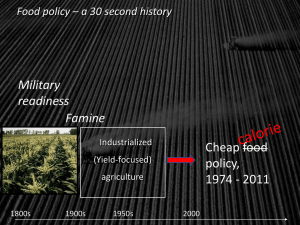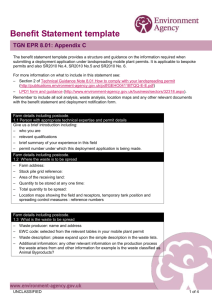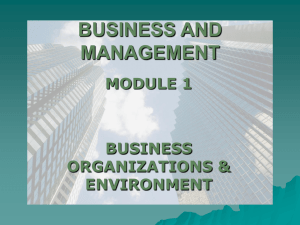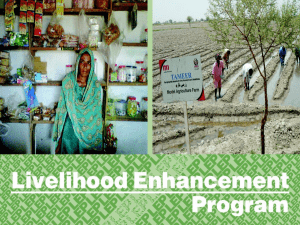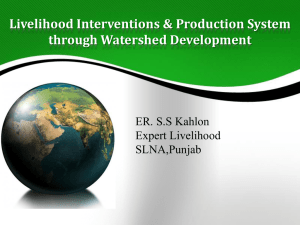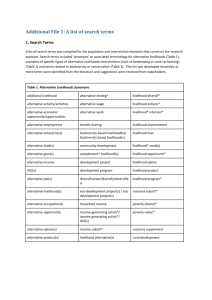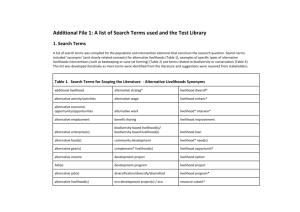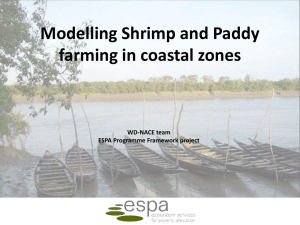LIVELIHOOD AND PRODUCTIVITY ENHANCEMENT
advertisement
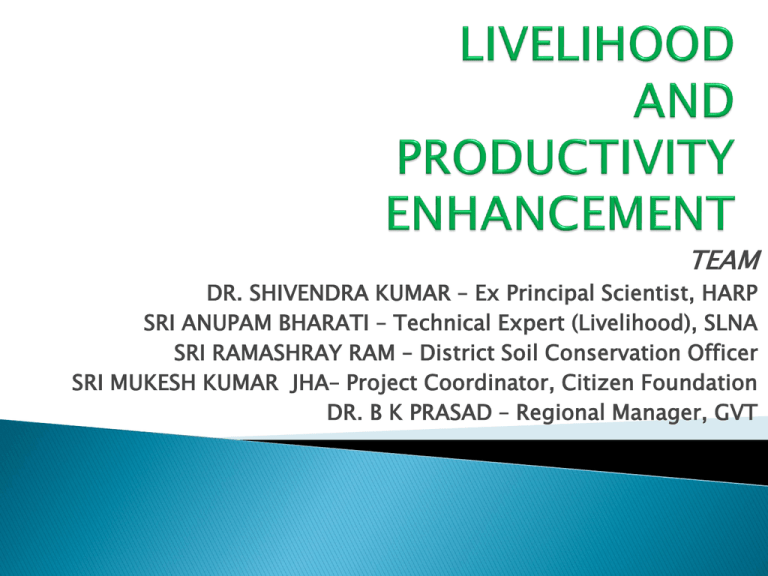
TEAM DR. SHIVENDRA KUMAR – Ex Principal Scientist, HARP SRI ANUPAM BHARATI – Technical Expert (Livelihood), SLNA SRI RAMASHRAY RAM – District Soil Conservation Officer SRI MUKESH KUMAR JHA– Project Coordinator, Citizen Foundation DR. B K PRASAD – Regional Manager, GVT Rainfed agriculture Over dependency of populace on agriculture Small landholding Low productivity per unit area Monocropping Hidden unemployment High Dependency on Traditional methods Extreme Poverty and lack of capital Low Risk bearing Capacity Unscientific approach Free grazing Institutional support can be obtained on various agricultural models and various types of agro-forestry modules to minimize risks and gain high returns through institutions like: Birsa Agricultural University, Ranchi Krishi Vigyan Kendra HARP – Palandu, Ranchi Indian Institute of Natural Resin and Gum, Ranchi Dept. of Agriculture ATMA National Horticulture Mission Fisheries Dept. Dept. of Animal Husbandry Dept. of Environment & Forests NABARD and other banks can be approached for financial support and credit plan Non Timber Forest Produce based Livelihood Animal Husbandry based Livelihood Agriculture Based Livelihood Informal Service Sector based Livelihood Off Farm Livelihood Opportunities Training module should be developed in each area in consultation with concerned organizations available in Jharkhand POP on different areas of intervention available with different line departments and research institutes may also be collected and referred. Lac Cultivation with primary processing to enhance its shelf-life and price Sustainable Gum Harvesting of important gum yielding trees – Palas, Dhawda, Seesam etc. Channelizing seed collection of oil yielding trees Leaf plate making as a potential of regular income Tamarind, Mahua, Bel, Chironji (Buchnania lanzan) based unit Bamboo based units Natural fibre based units like Tasar, Sisal, Sabai Leaf Composting units including forest leaf litter, lantana, parthenium, farm weeds etc. Goatery units with breed improvement Piggery units Dry Duckery units Poultry Units Aqua-culture For all these activities literature on POP is available. Exposure visits can be organised at BAU, Ranchi and its KVKs, HARP, IINRG, KGVK, GVT, Ram Krishna Mission and Fisheries Department Over dependency on crop like paddy requiring more water for cultivation should be reduced and less water requiring crop should be promoted not as a contingent plan but a plan for ensured income utilising minimal moisture and covering lager area under multi-tier cropping and intercropping model like: Vegetable farming with tuber crops– well known for its climatic support Promotion of Legume crops – Arahar, Urd, Kulthi, pea, gram Oil seed promotion – Niger, peanut Under horticulture peach and pear based agroforestry package is suggested for high altitude areas Establishment of Resource Centre for Agri- Equipments and Agri – Services (for young entrepreneurs and BTM/ATM) Panchayat level Seed Exchange Centres Establishing Grain Bank Establishing Grading and Packaging Units Providing Cool Chamber/Solar Dryer facilities for Crop storage (Post Harvest Facilities) Seed Treatment based Services Soil Test facilities at farm with specific recommendation based on farmers requirement and his field. Developing team of village level experts based on need of programme such as GPS supported photography, developing case studies for documentation, web monitoring Establishing Dal Mills Murhi Making Units Establishing Oil Expellers at village Cluster level Portable Rice Mill and Paddy Dehusking Units Leaf/Paper plate Making Units Bamboocraft based Value addition units Tailoring Units Solar Light Based Units Pump set and Tube-well Repairing Units Identification and exposure of specific area based on successful cropping and marketing such as Bero (Kharif potato, Peas and ginger), Pithoria (Cauliflower and Cabbage), Mandar (French bean, Capsicum, Jack fruit), Gola (Cucurbits, sweet potato), Hazaribag (Tomato, Coriander, Chilli). Concept of organic farming in forest fringe areas and exploring opportunities of recycling crop residues and farm wastes for re- vitalizing of soil. Introduction and dissemination of suitable soil microbes as recommended by local research institutions like BAU, HARP Methods to check soil nutrient loss, moisture loss and water harvesting should be promoted to enhance per unit productivity. Developing crop specific package of practices in consultation with research institutions including cost estimates. Collection of training manuals and pamphlets from concerned departments like Agriculture Dept., ATMA, NHM, BAU, Soil Conservation Dept., Tasar Research Institute, IINRG. Production system analysis should be made to derive specific crop cycle like – Paddy – Potato – Vegetable Paddy – Chick pea – Vegetable Fruit based MTAS Composite Farming Establishing community based nursery to meet requirements Collective procurement of inputs Custom hiring centre for farm equipments Resource Centers for primary processing Collective sale of farm produce Establishing grain banks and seed exchange centre Case study of MASUTA, PRADAN (Poultry) may be explained Film shows and handouts for better dissemination Providing contact no. and names of Kisan Mitra, Udyan Mitra, ATM, BTM, BAIF Centre representatives to each farmer

